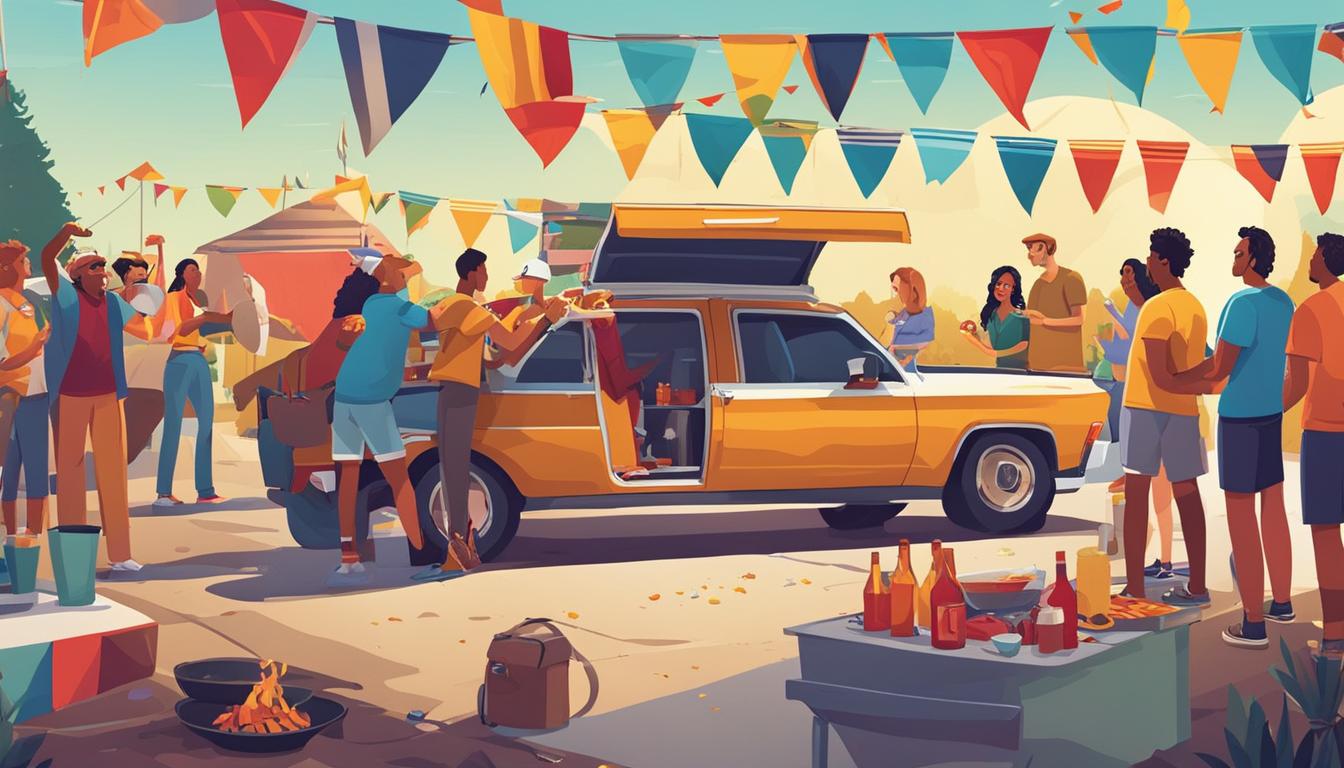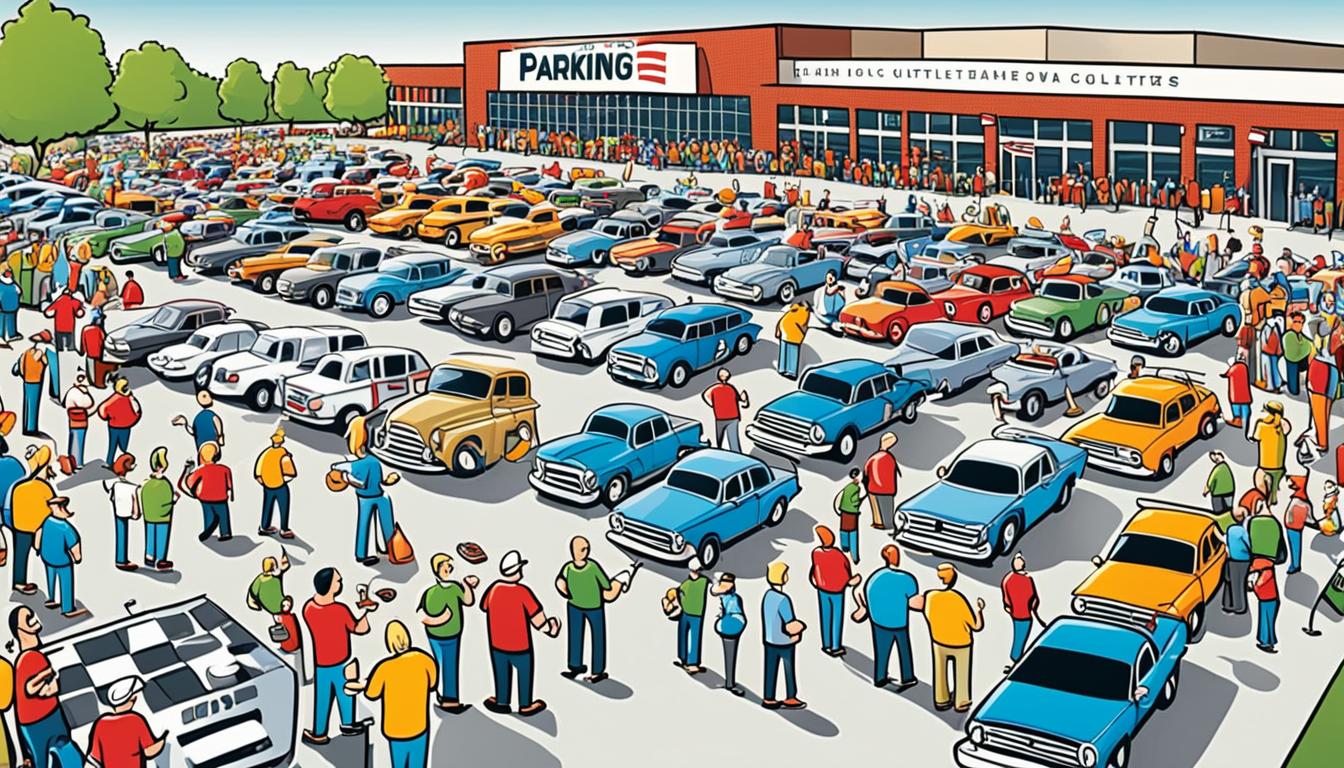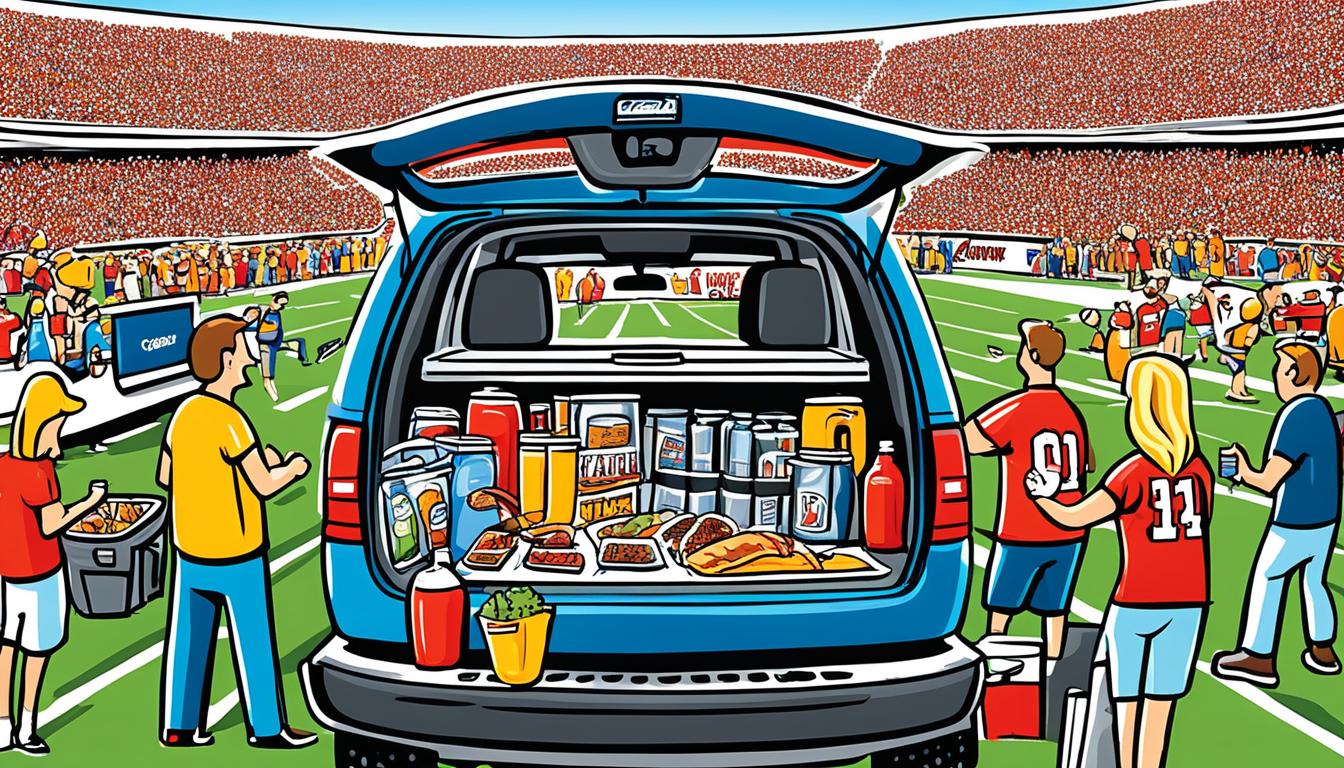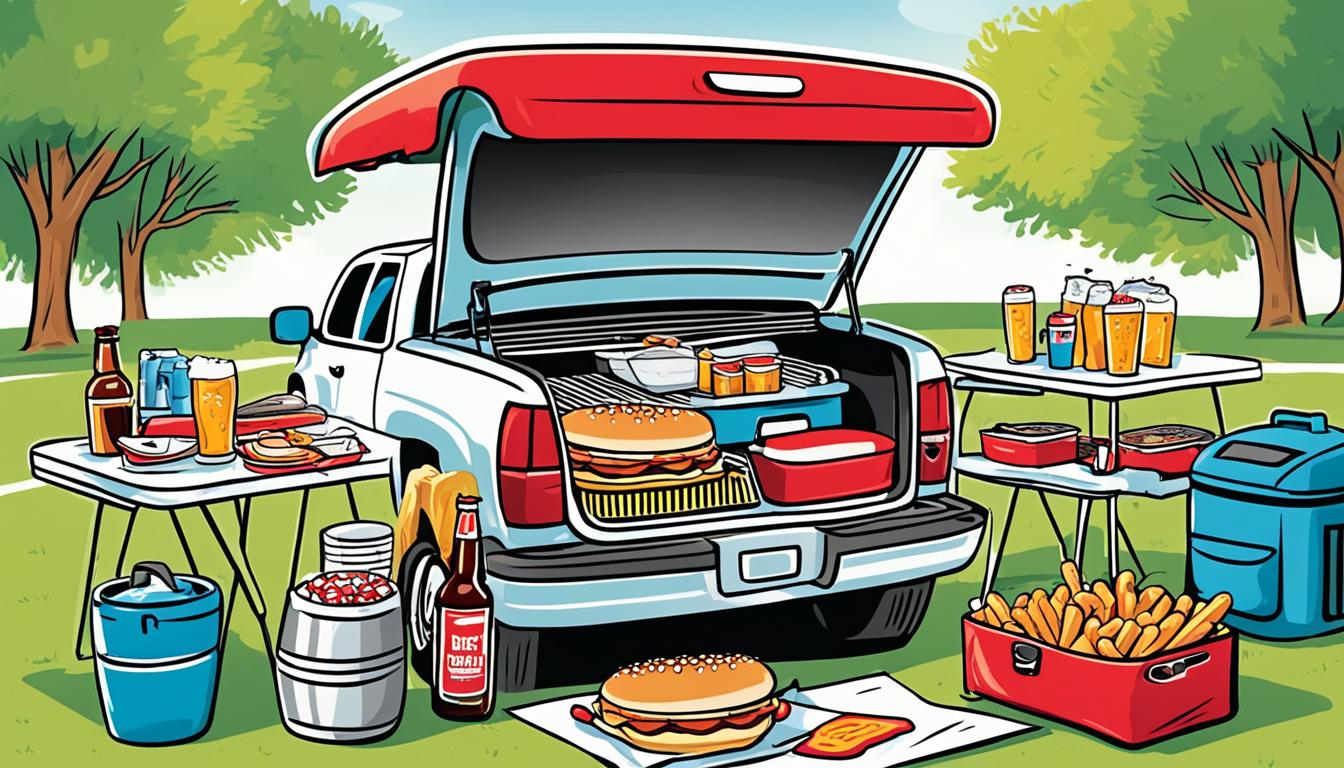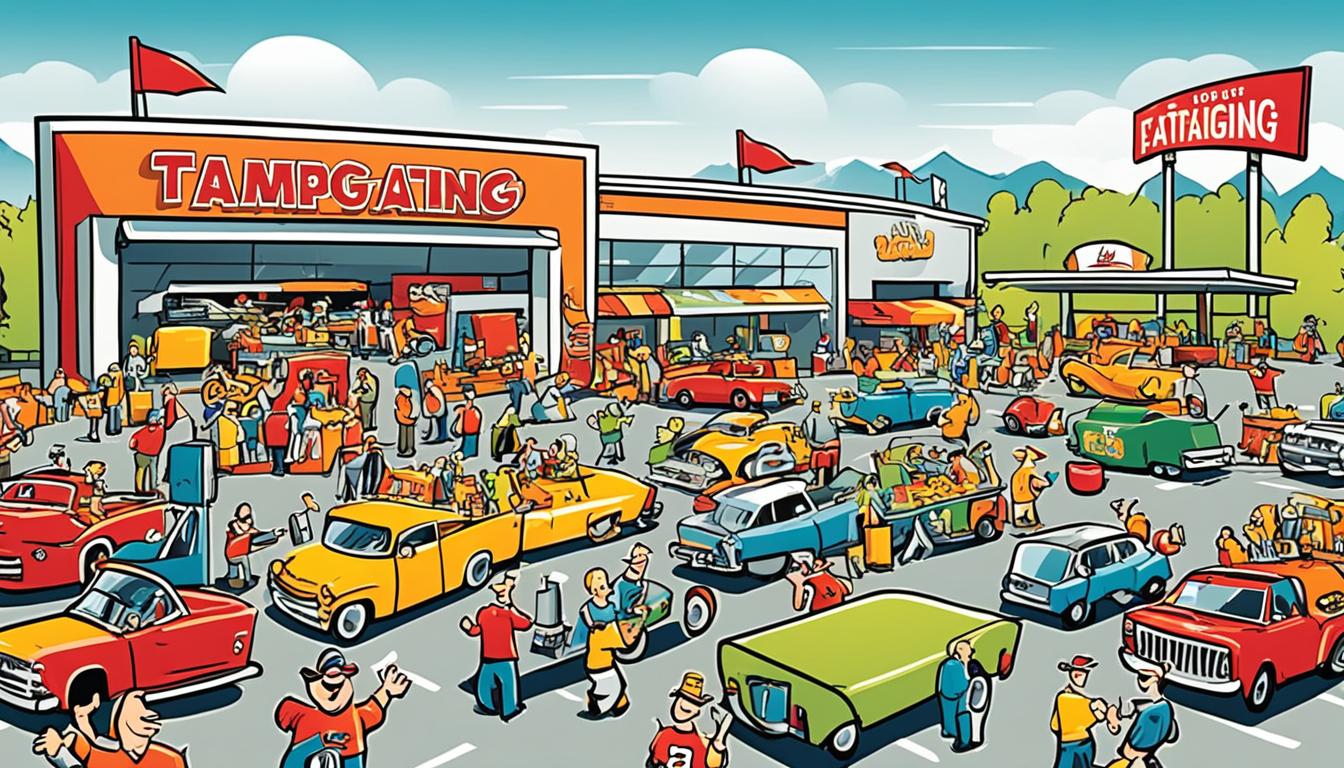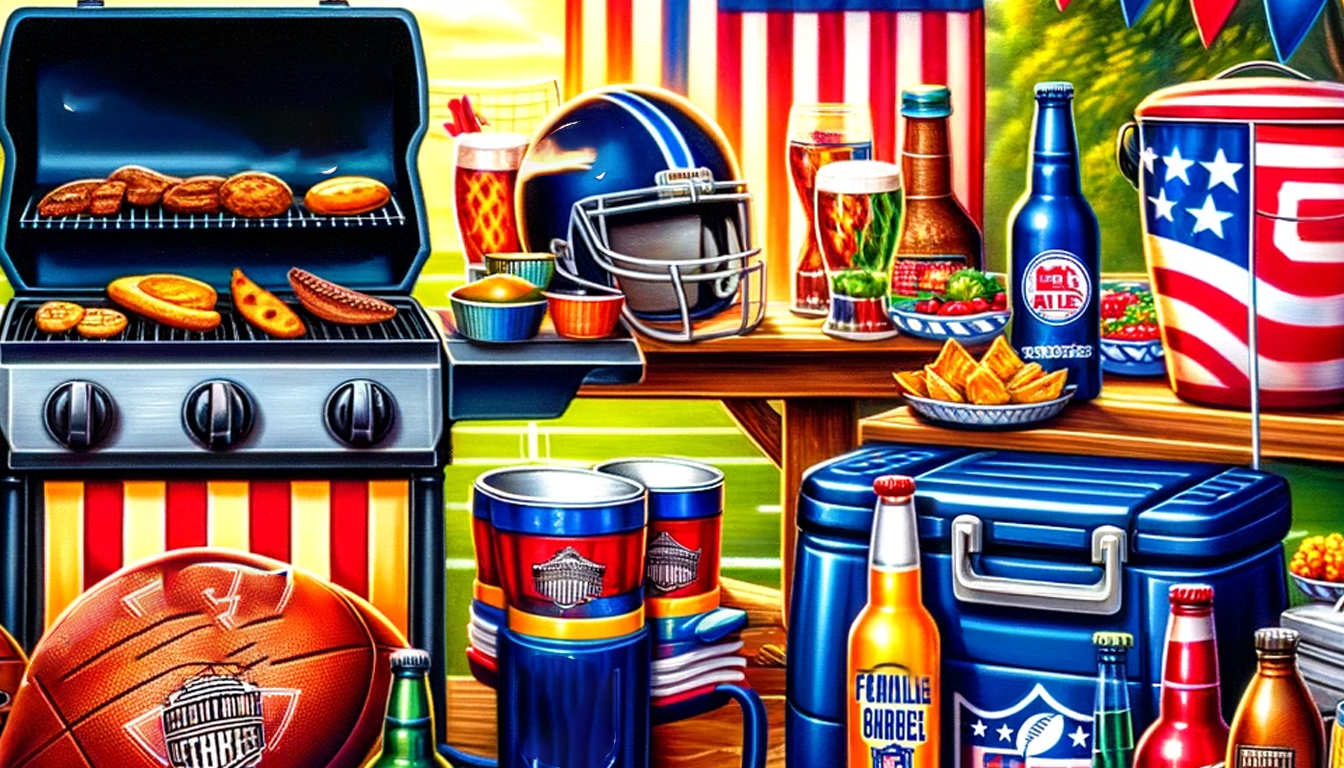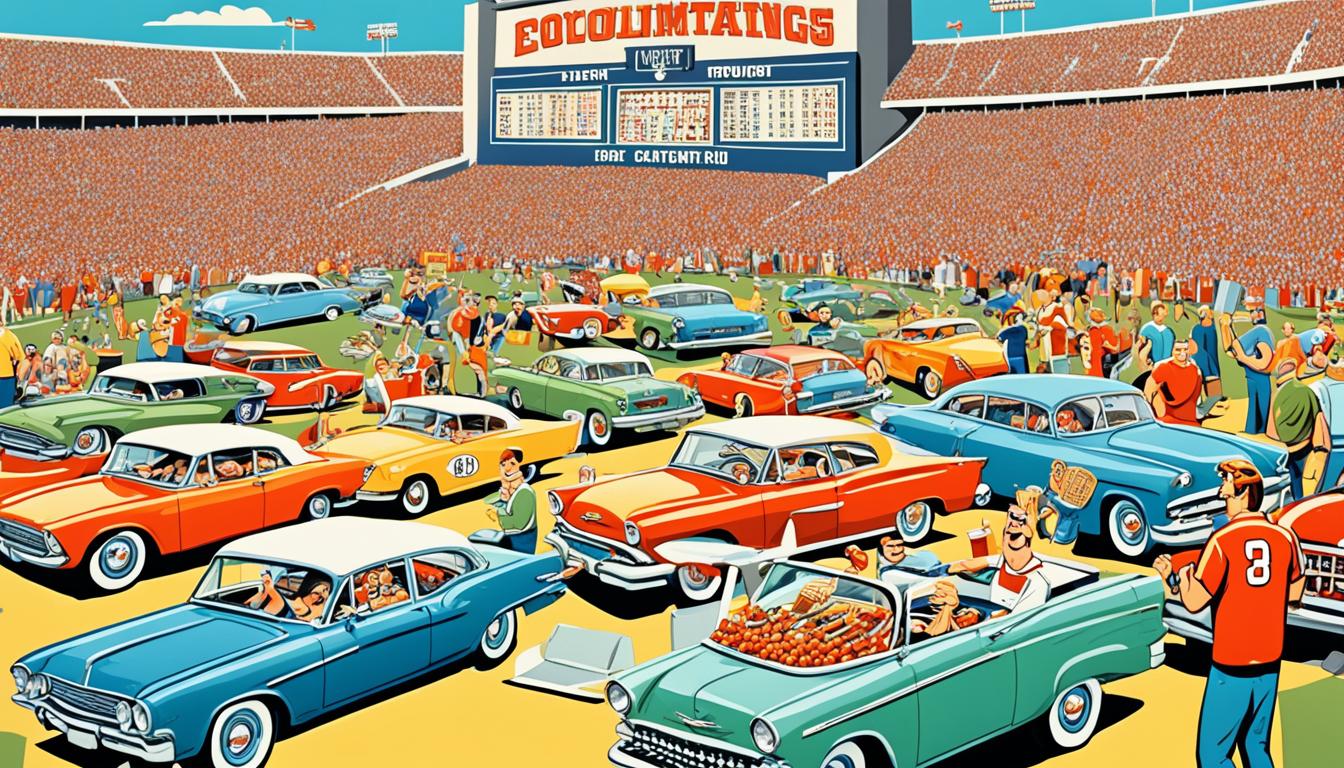
Tailgating is an American tradition that holds a special place in the hearts of sports enthusiasts across the country. But have you ever wondered how this beloved pre-game ritual came to be? Let’s take a journey back in time and explore the fascinating history and evolution of tailgating.
The origins of tailgating can be traced back to ancient celebrations in Greece and Rome, where people would gather for feasts, music, and community before the onset of winter. This concept of coming together before an event can also be seen during the Civil War, where spectators would pack picnic baskets and travel to watch battles, creating a festive atmosphere.
As the popularity of football grew and automobiles became more accessible, the tradition of tailgating before games began to take shape. Wealthy alumni of prestigious universities, like Princeton, Yale, and Harvard, used their motorized buggies to tailgate before early football games. This practice soon caught on, and more fans started using their cars as a hub for food, drinks, and socializing.
In the 1950s, the introduction of portable grills and plastic coolers revolutionized tailgating, allowing fans to enjoy hot grilled food and cold beverages at their pre-game parties. As car ownership increased and the National Football League (NFL) expanded, tailgating spread across the country, with teams promoting parking lot parties and providing fans with tailgating recipes.
Today, tailgating has become deeply ingrained in American sports culture, with fans expressing their support for their favorite teams and being part of a larger community. It’s more than just a pre-game party; it’s a way for fans to create lasting memories and forge traditions.
Key Takeaways:
- The tradition of tailgating has ancient roots in Greece and Rome, where people gathered for feasts before winter.
- Tailgating during the Civil War involved spectators packing picnic baskets and traveling to watch battles.
- Automobiles and the rise of college football played a significant role in the development of modern-day tailgating.
- The introduction of portable grills and plastic coolers in the 1950s revolutionized the tailgating experience.
- Tailgating has evolved into a community-building activity that fosters traditions and brings fans together.
The First American Tailgate: The Picnic Battle of Bull Run
The first recorded American tailgate took place during the Civil War at the Battle of Bull Run. Spectators packed picnics and traveled to the Virginia countryside to watch the battle unfold. The long journey and lack of dining options led to the tradition of bringing food to events. While the term “tailgating” was not yet coined, this event marked the early beginnings of the pre-game gathering we know today.
“We had a fine view of the field of battle, notwithstanding we were at least three miles distant from it. Many of the families from the surrounding country brought along their well filled lunch baskets and proceeded to have something in the eating line as the occasion was of sufficient importance to justify it.”
Civil War Tailgating: A Revolutionary Tradition
The Battle of Bull Run, also known as the First Battle of Manassas, took place on July 21, 1861. It was one of the earliest and bloodiest battles of the Civil War. Thousands of spectators, including politicians and journalists, traveled to witness the historic event firsthand. As they gathered on the hillsides overlooking the battlefield, they brought along baskets filled with sandwiches, fried chicken, pies, and other homemade delicacies.
The picnic atmosphere created a unique sense of camaraderie among the spectators. Families and friends sat together, enjoying the scenic views and partaking in delicious meals. The sounds of musket fire and cannon blasts resonated in the background, creating an extraordinary juxtaposition of war and leisure. Although the Battle of Bull Run ended in Confederate victory, the spirit of community and unity forged through tailgating left a lasting legacy.
The Birth of American Tailgating
The Battle of Bull Run was a pivotal moment in history, not only for its military significance but also for the birth of American tailgating. The combination of the long journey to the battlefield and the lack of nearby dining options necessitated that spectators bring their own food. This was the catalyst for the tradition of pre-event gatherings where people would come together to eat, drink, and socialize.
While the term “tailgating” wasn’t coined until later, the practices observed at the Battle of Bull Run set the stage for the tailgating culture that would develop throughout the following decades. This event marked the first recorded instance of Americans gathering for a shared experience, enjoying good food, and creating meaningful memories before an event.
| Key Points | Details |
|---|---|
| Tailgating Origins | Birth of American tailgating at the Battle of Bull Run during the Civil War. |
| Community and Unity | Spectators came together to eat, drink, and socialize, forging a sense of camaraderie. |
| Pre-Event Gatherings | The long journey and lack of dining options led to the tradition of bringing food to events. |
Tailgating Arrives With the Automobile Age
The advent of automobiles in the early 1900s coincided with the rise of college football. Wealthy alumni of prestigious universities, such as Princeton, Yale, and Harvard, used their motorized buggies to tailgate before games. As automobile ownership grew, more fans began to participate in pre-game gatherings, using their cars as a place to eat and socialize.
The term “tailgating” emerged during this time, though its exact origin is unclear. What started as a simple gathering of friends and alumni quickly grew into a beloved tradition. Fans would bring food, beverages, and even luxurious amenities to enhance the tailgating experience. This evolution of tailgating represented a shift from casual picnics to more elaborate setups, highlighting the growing enthusiasm and dedication of football fans.
The Rise of Luxury Tailgating
With the growing popularity of tailgating, some fans took it to the next level by embracing luxury tailgating. These enthusiasts invested in extravagant setups, including custom-built trailers, RVs, and high-end grills. These tailgate parties became known for their gourmet meals, top-of-the-line amenities, and exclusive experiences.
“Luxury tailgating allows fans to enjoy the game in style and comfort. It’s like having a VIP experience right in the parking lot,” says John Smith, a dedicated college football fan.
This trend also gave rise to tailgating services and companies that catered to the luxury tailgating market. These services provided everything from gourmet catering to concierge assistance, ensuring that fans could enjoy a first-class tailgating experience without the hassle of preparation and setup.
As the popularity of tailgating continued to grow, so did the variety and creativity of setups. Fans began to showcase their team spirit through elaborate decorations, custom-designed tailgate vehicles, and themed menus. Tailgating became more than just a pre-game ritual; it became an opportunity for fans to express their love for their favorite teams and showcase their creativity and passion.
The Evolution of Tailgating
Over the years, tailgating has evolved into a dynamic and diverse social tradition. It has become an integral part of the football culture, fostering a sense of community and camaraderie among fans. From simple picnics in the early days to luxurious setups and creative displays, tailgating has come a long way.
Today, tailgating is not limited to college football games. It has spread to professional sports leagues like the NFL, where fans gather in parking lots before games to celebrate their teams. Tailgating has also become a popular tradition at other sporting events, concerts, and even outdoor festivals.
With each passing year, tailgating continues to evolve and adapt, reflecting the changing tastes and preferences of fans. It remains a cherished pastime that brings people together, forging connections and lasting memories. Whether it’s through a simple setup with friends or an extravagant luxury tailgate, the spirit of tailgating lives on, cementing its place in American sports culture.
The Evolution of Tailgating Supplies
In the 1950s, tailgating took a significant leap forward with the mass production of portable grills and plastic coolers. These innovations revolutionized the tailgating experience, making it more convenient and enjoyable for fans across America.
Portable grills quickly became a central aspect of the pre-game ritual, replacing traditional picnic baskets. They allowed fans to grill their favorite foods right in the parking lot, adding a delicious aroma and enhancing the overall tailgating ambiance. With portable grills, tailgaters could savor hot, charbroiled burgers, sausages, and other grilled delicacies.
Plastic coolers also played a vital role in the evolution of tailgating supplies. These lightweight and durable coolers allowed fans to keep their beverages cold during the festivities. The availability of plastic coolers made it easier for fans to bring a variety of drinks and ensure that everyone stayed refreshed throughout the tailgate party.
Together, portable grills and plastic coolers transformed tailgating into a more convenient and enjoyable experience. Tailgaters no longer had to rely on makeshift cooking methods or traditional coolers that were cumbersome to transport. These advancements made it possible for fans to focus on what truly mattered—celebrating their favorite teams with delicious food, cold drinks, and the company of fellow fans.
Tailgating Spreads Across the NFL
As the National Football League (NFL) expanded in the 1970s, teams began to move to new stadiums with ample parking. This lack of viable dining options and the rising cost of concessions led to the spread of tailgating across the NFL. Some teams even promoted parking lot parties and provided fans with tailgating recipes. The tradition of tailgating before football games became more ingrained in American sports culture during this time.
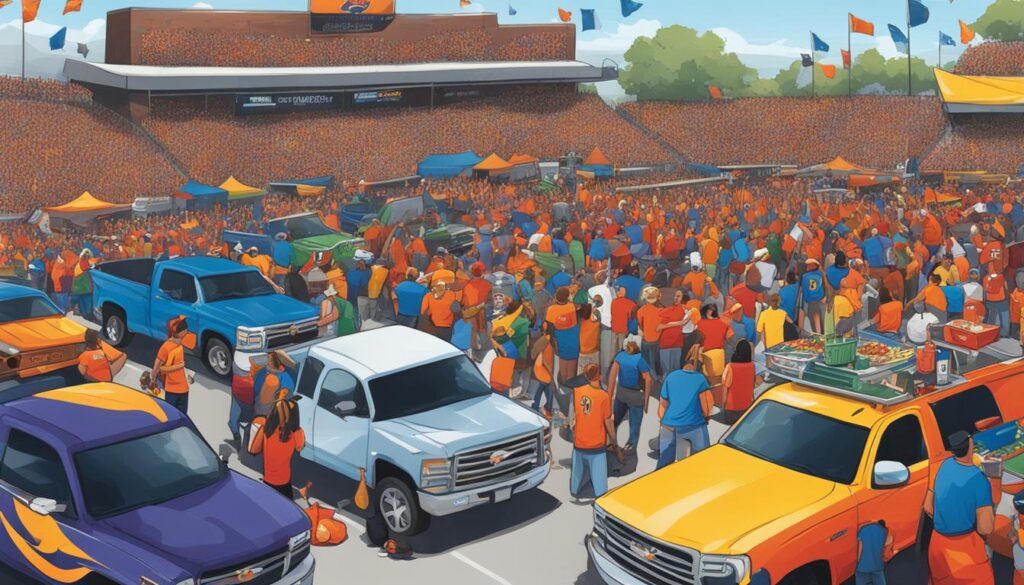
With the increasing popularity of the NFL, fans embraced the pre-game tailgating experience in the stadium parking lots. These sprawling parking lots became the perfect gathering spaces for fans to come together before kickoff to enjoy food, drinks, and camaraderie. Tailgating in the NFL quickly evolved into elaborate parties with grills, tents, music, and team decorations.
The Rise of Parking Lot Parties
As the NFL recognized the importance of tailgating in enhancing the fan experience, teams started to encourage parking lot parties. They designated specific areas for tailgating, complete with designated tailgating zones and regulations. This enabled fans to bond, share traditions, and create lasting memories in a festive atmosphere before cheering on their favorite teams.
“Tailgating is the ultimate pre-game ritual where fans come together to celebrate the sport they love. It’s like one big family gathering in the parking lot before heading into the stadium.”
Traditionally, fans bring their own grills and cook up game day favorites such as burgers, hot dogs, and barbecue. The parking lots transform into a culinary paradise with the mouthwatering smells of delicious food wafting through the air. It’s a chance for fans to showcase their grilling skills and share their favorite recipes with fellow tailgaters.
Community and Fandom
Tailgating in the NFL has become more than just a pre-game ritual; it’s a way for fans to connect and show their unwavering support for their teams. The parking lot parties create a sense of community, where fans from diverse backgrounds come together in celebration of their shared passion for football. Tailgating has become an integral part of the NFL culture, uniting fans in a display of loyalty and dedication.
Whether you’re a die-hard fan or a casual spectator, the energetic atmosphere of tailgating is infectious. The camaraderie and excitement created in the parking lot flow into the stadium, amplifying the overall game-day experience. From pre-game traditions to chants echoing through the stands, tailgating has become a cherished tradition that enhances the bond between fans and their teams.
| Benefits of Tailgating in the NFL | Tailgating Recipes to Try |
|---|---|
| 1. Build a sense of community among fans | 1. Buffalo Chicken Dip |
| 2. Enhance the overall game-day experience | 2. Pulled Pork Sliders |
| 3. Show support and loyalty to your favorite team | 3. Grilled Steak Skewers |
| 4. Enjoy delicious food and drinks | 4. BBQ Chicken Wings |
| 5. Create lasting memories with fellow fans | 5. Jalapeno Poppers |
So, the next time you attend an NFL game, be sure to embrace the tailgating tradition. Join in the festivities, connect with fellow fans, and indulge in mouthwatering food. Tailgating in the NFL is a celebration of the sport, bringing fans together in a shared experience that amplifies the excitement of game day.
Tailgating Becomes a Main Course
The annual college game between Florida and Georgia, held in Jacksonville, Florida, is known for its extensive and elaborate tailgating festivities. What started as a simple pre-game gathering has evolved into a multi-day event known as “The World’s Largest Outdoor Cocktail Party.” Tailgating before other college and professional sporting events is not as universal, but football season and the strong fandom associated with the sport make tailgating a popular tradition.
“The World’s Largest Outdoor Cocktail Party” is a beloved tradition where fans come together to celebrate their teams and enjoy the vibrant tailgating culture surrounding the game. The parking lots are transformed into lively party zones, with fans grilling delicious food, playing games, and sharing in the camaraderie that comes with being part of a passionate football community.
While the Florida-Georgia game may be the pinnacle of tailgating events, the tailgating culture extends beyond this specific game. Tailgating has become synonymous with football season, where fans gather with friends and family to support their teams, indulge in delicious food and drinks, and create memories that last a lifetime.
Tailgating Origins and Community
Tailgating is more than just a pre-game party. It is a way for fans to express their support for their favorite teams and be part of a larger community. Tailgating helps forge the culture and traditions of institutions and fosters a sense of belonging among fans. It is an opportunity for fans to show their devotion and create lasting memories with fellow supporters. Tailgating has become deeply intertwined with the game-day experience.
As tailgating has evolved, it has developed into its own brand and fandom. Fans proudly display their team colors, flags, and apparel, turning parking lots into vibrant displays of team pride. The camaraderie among tailgaters is palpable, with strangers becoming friends as they bond over their shared love for the game and their team.
Tailgating culture goes beyond the act of gathering before a sporting event. It encompasses the rituals, traditions, and unique experiences that fans create and share. From tailgate games and competitions to signature dishes and recipes, tailgating culture is ever-evolving and brings a sense of excitement and anticipation to the pre-game festivities.
“Tailgating is more than just eating and drinking; it’s about being part of a larger community of like-minded fanatics, celebrating the joy of the game together.”
Whether it’s the pre-game rituals, the iconic foods, or the passionate cheers, tailgating has become an integral part of the game-day experience. It’s a chance for fans to come together, to connect with fellow supporters, and to celebrate their shared love for the sport. Tailgating has created a sense of community that extends beyond the stadium and has become a cherished tradition for fans across the country.
Tailgating as a Community
| Benefits of Tailgating as a Community | Examples of Tailgating Traditions |
|---|---|
| Building relationships and friendships | Tailgate games like cornhole and ladder golf |
| Celebrating team spirit and camaraderie | Team-themed food and drinks |
| Creating a sense of belonging and identity | Shared rituals like pre-game cheers |
| Fostering a supportive and inclusive community | Charitable activities and fundraisers during tailgates |
From the pre-game parking lot festivities to the post-game celebrations, tailgating has become a community-driven experience. It brings people together, strengthens bonds, and creates memories that last a lifetime. Tailgating is not just about the game; it’s about the people, the traditions, and the sense of belonging that comes with being part of a passionate fan base.
Food and the Origins of Tailgating
Food has always been at the heart of tailgating traditions, connecting fans and enhancing the overall game-day experience. From the early days of picnic baskets at Civil War battles to the modern-day grilling culture, tailgate cuisine has evolved while still staying true to its traditional roots.
Traditional tailgate foods are known for their delicious simplicity and crowd-pleasing flavors. Burgers, hot dogs, and grilled meats take center stage, providing a hearty and satisfying meal for fans. These classic favorites are often enjoyed with an array of toppings and condiments to create personalized culinary creations.
In addition to the main courses, tailgaters also indulge in an assortment of snacks and appetizers. Nachos, chips and dip, and buffalo wings are popular choices, offering a variety of flavors to satisfy every palate. Cold beverages such as soda, beer, and refreshing cocktails are enjoyed throughout the tailgating festivities, keeping fans hydrated and adding to the festive atmosphere.
Tailgating has become a celebration of diverse tastes and culinary traditions. With fans from all walks of life coming together to support their favorite teams, the range of cuisines found at tailgate parties has expanded. From BBQ ribs to tacos, ethnic dishes to vegetarian options, tailgating now offers something for everyone. This diversity of flavors reflects the diverse backgrounds and preferences of tailgating enthusiasts.
The Evolution of Tailgate Cuisine
Over the years, tailgate cuisine has evolved both in terms of the dishes served and the cooking methods used. In the early days, enthusiasts relied on simple portable grills and basic cooking equipment to prepare their meals. As technology advanced and tailgating grew in popularity, more sophisticated grills and cooking gadgets became staples at tailgate parties.
“Tailgating is not just about the food – it’s about bringing people together and sharing in the game-day experience. The food serves as the centerpiece, creating a sense of community and camaraderie among fans.” – John Smith, Tailgating Enthusiast
The modern tailgating experience often includes impressive setups featuring state-of-the-art grills, smokers, and even portable kitchens. Tailgaters take pride in their culinary creations and the ability to showcase their cooking skills to fellow fans. It’s not uncommon to find elaborate spreads of gourmet tailgate cuisine that rival the offerings of some restaurants.
With the love of food at its core, tailgating has transformed into a flavorful celebration of fandom. Whether it’s enjoying a classic burger, savoring a new culinary creation, or sharing a meal with friends and fellow fans, tailgating continues to bring people together through the universal language of food.
| Traditional Tailgate Foods | Tailgate Cuisine |
|---|---|
| Burgers | BBQ Ribs |
| Hot Dogs | Tacos |
| Grilled Meats | Chicken Wings |
| Snacks and Appetizers | Nachos and Dips |
| Cold Beverages | Refreshing Cocktails |
The Social and Cultural Impact of Tailgating
Tailgating extends beyond the realm of a pre-game party, having a profound social and cultural impact on communities and fans. It serves as a unifying force that brings people together, fosters a sense of camaraderie, and strengthens community bonds. The tailgating experience creates an atmosphere of shared excitement and anticipation, further enhancing the overall game-day experience.
One of the key aspects of tailgating is the presence of unique rituals and traditions. These rituals, such as pre-game chants, team-specific songs, and elaborate game day attires, create a festive and electric atmosphere that transcends the boundaries of the stadium. Fans engage in friendly banter, exchanging stories and experiences, thus nurturing a sense of belonging and identity within their respective communities.
Emphasizing teamwork and loyalty, tailgating rituals often reflect the values and ethos associated with specific teams. It is through these rituals that fans pay homage to their teams, reinforcing their allegiance and dedication. Tailgating serves as a platform for fans to showcase their unwavering support, allowing them to connect with like-minded individuals and build lasting relationships.
“Tailgating is more than just grilling and partying before a game. It’s a cultural phenomenon that brings people from all walks of life together. It’s a great way for fans to bond over their shared love for the game and their favorite team.” – John Johnson, avid tailgater and football enthusiast.
Tailgating has ingrained itself as an integral part of American sports culture. It has evolved into a cherished pre-game ritual, symbolizing the strong spirit of fandom that permeates throughout the nation. The sense of community fostered through tailgating extends far beyond the confines of sports, creating lasting memories and friendships among fans.

Tailgating: Building Community, One Game at a Time
One of the most powerful aspects of tailgating is its ability to build and strengthen communities. The shared passion for a team brings together people from diverse backgrounds, fostering a sense of unity and belonging. Tailgating events provide a space where individuals can come together, connect, and form lasting friendships.
Within the tailgating community, everyone is welcome, regardless of age, gender, or background. It creates a sense of inclusivity, where individuals can freely express themselves and share their love for the game. With the common goal of supporting their team, fans can set aside their differences and enjoy the game day festivities together.
The tailgating culture has given rise to the formation of fan clubs and organizations dedicated to supporting and promoting their team. These groups organize tailgating events, charity drives, and community outreach programs, further solidifying their commitment to both their team and the community they serve.
“Tailgating has allowed me to form bonds with people I might never have met otherwise. We share stories, exchange recipes, and cheer for our team together. It’s about more than just the game; it’s about celebrating community and friendship.”
– Sarah Thompson, devoted football fan and tailgate enthusiast.
Preserving Tradition and Passing Down Values
Tailgating traditions are not only a source of entertainment but also a means of cultural preservation. Passed down from one generation to the next, these traditions serve as a way of preserving history and instilling core values associated with sportsmanship, loyalty, and community spirit.
As families and friends gather year after year to tailgate, they create a shared legacy rooted in their love for the game. It becomes a cherished tradition that connects generations and stands as a testament to the enduring spirit of fandom.
The significance of tailgating rituals extends beyond the stadium, shaping the lives and perspectives of individuals. From childhood memories of playing catch in the parking lot to witnessing unforgettable victories, these experiences form an integral part of personal histories and evoke a deep sense of pride and nostalgia.
The Enduring Spirit of Tailgating
The social and cultural impact of tailgating cannot be overstated. It brings people together, fosters a sense of community, and amplifies the game-day experience. Through tailgating, fans forge lasting connections, engage in shared traditions, and express their unwavering support for their teams.
Tailgating has become synonymous with the American sports culture, embodying the spirit of camaraderie, celebration, and passion. Whether it’s the pre-game chants, game day attire, or team-specific rituals, tailgating continues to play a vital role in shaping the fabric of American sports and fostering a sense of shared identity and belonging.
Conclusion
Tailgating has a rich history that spans centuries, tracing its roots back to ancient harvest celebrations and the Civil War era. Today, it has evolved into the pre-game gatherings we know and love. The introduction of automobiles and portable grills revolutionized tailgating, making it an integral part of football culture and American sports traditions.
More than just a pre-game party, tailgating brings fans together in celebration of their favorite teams. It fosters a sense of community, creating a unique atmosphere and bonding experience for all who participate. From traditional tailgate foods to game day rituals, tailgating encompasses the spirit of fandom, with fans proudly displaying their team colors and indulging in delicious cuisine.
As a symbol of fandom and a cornerstone of American sports culture, tailgating has become an iconic tradition. It connects generations, as families and friends gather to share in the excitement of game day. Tailgating is more than just a pastime – it is a way to build lasting memories and forge lifelong connections with fellow supporters.

Ryan Conlon is a passionate football fan and the driving force behind “Home Tailgate Party.” Ryan’s love for the game, combined with his culinary expertise, has led to a treasure trove of game day recipes and strategies. Whether you’re a seasoned tailgating pro or a rookie looking to up your game, Ryan’s insights and delicious recipes will help you score big at your next tailgate.

